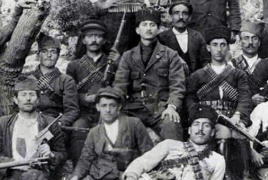How Armenian resistance fighters inspired Jews to resist Nazi genocide April 28, 2021 - 11:11 AMT PanARMENIAN.Net - When Jewish fighters in Nazi-built ghettos were looking for inspiration to resist deportation to the death camps, they turned to a fact-based novel about the Armenian Genocide, Times of Israel says in a new article about how Armenian fighters inspired Jews to resist Nazi genocide. Written by Prague-born Franz Werfel, “The Forty Days of Musa Dagh” was tailor-made for the plight of aspiring resisters. The novel, published in 1933, fictionalized the siege of Musa Dagh — Turkish for “Mount Moses ” — where 250 Armenian fighters held off Ottoman-Turkish forces for nearly two months in 1915. Since then, Turkey’s government has denied a genocide took place during World War I. This week, United States President Joe Biden officially recognized the murder of 1,500,000 Armenians by Ottoman-Turkish forces as a genocide. Israel has continued to stop short of recognition. Although Armenian fighters held out at Musa Dagh for 53 days, Werfel made the siege last 40 days to resonate with the Old Testament. The German-language novel brought the Armenian genocide to the attention of millions of people around the world, in turn helping to raise significant funds for the refugees. “To be an Armenian is an impossibility,” according to an old Armenian saying included by Werfel in “Musa Dagh.” Six years after the novel was published, Nazi Germany started to conquer Europe. Almost instantly, copies of “The Forty Days of Musa Dagh” spread like wildfire among young adults, some of whom found themselves in circumstances similar to those faced by Armenians during the previous war. Decades after the massacres of the Genocide, for ghetto-imprisoned Jews, the Armenian atrocities resonated with accounts coming from Jewish communities in eastern Europe. As the novel was devoured in dozens of ghettos, thousands of Jews determined to take matters into their own hands when the time was right. In the Warsaw ghetto, “The Forty Days of Musa Dagh” was the most popular book in circulation. When Jewish resisters decided to fight back in the Bialystok ghetto, they spoke of the ghetto’s “Musa Dagh” moment at the planning meeting. “Only one thing remains for us: to organize collective resistance in the ghetto, at any cost; to consider the ghetto our ‘Musa Dagh’ — to write a proud chapter of Jewish Bialystok and our movement into history,” wrote Mordechai Tannenbaum. “If you read [Werfel’s book], you will remember it for the rest of your life,” said Tannenbaum. In Lithuania’s Vilna ghetto, “The Forty Days of Musa Dagh” was the most popular book in circulation, reported librarian Herman Kruk. Jewish resisters attempting to flee the ghetto to join partisan units “passed the book from hand to hand,” according to reports. Throughout eastern Europe, Jewish resisters used the term “to organize a Musa Dagh.” Warsaw ghetto historian Emanuel Ringelblum wondered on paper, “What, the world will ask, did people think of on Musa Dagh?” As far west as the Netherlands, accounts from the Dutch “underground” pointed to the novel’s tremendous popularity among resisters to Nazism everywhere. Jews trapped in the ghettos of Nazi-occupied Europe were not the only ones deriving inspiration from “The Forty Days of Musa Dagh.” In pre-state Israel, Jewish leaders were actively preparing for the prospect of a German invasion. The defense plan called for creating a Masada-like fortress atop Mount Carmel, where Jewish fighters could retreat for a “last stand” against German forces. Although the plan is largely remembered as “The Masada Plan” or “The Carmel Plan,” it was also referred to as the “Musa Dagh Plan.” For months, the area around Haifa was stocked with weapons and supplies to hold out against a German siege, while fortifications were erected. The foreign ministers of Armenia and Azerbaijan, Ararat Mirzoyan and Jeyhun Bayramov, have arrived in Washington. The CSTO budget for the current year requires adjustments due to the refusal of Yerevan to pay their share of contributions. Six total incidents have burned 19 old-growth trees. Friday night 8 trees were torched along the beautiful main entrance. The EU does not intend to conduct military exercises with Armenia, Lead Spokesperson for EU Foreign Affairs and Security Policy Peter Stano says. Partner news |